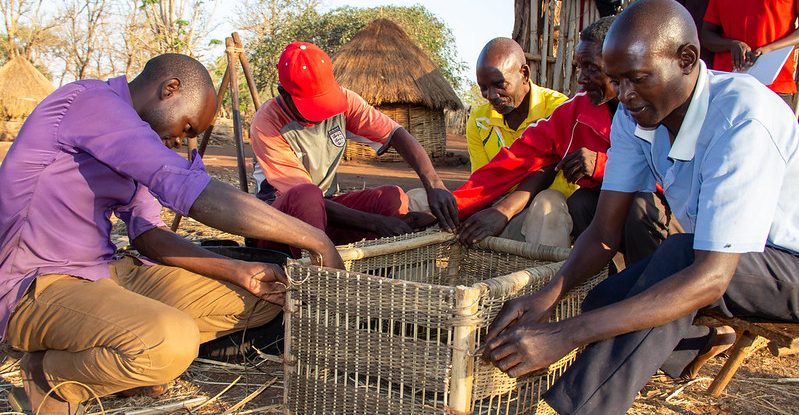“I have no forest,” lamented Chief Ndake of the Ndake Chiefdom in Eastern Zambia. Once lush with dense bamboo groves, the district’s Vizimumba Ward is now characterized by open agricultural spaces, sparse trees, and small shrubs. Its residents face the complex and interlocking impacts of climate change, a growing population, and diminishing bamboo resources: harvesters are compelled to make longer and longer journeys into the forests to get what they need to make products for sale and for household needs.
Bamboo has been woven into the community’s daily lives and livelihoods for generations. It features in multiple forms, from fences, silos, and a broad range of household and farming uses, to community markets and places of worship. As reduced rainfall makes agriculture increasingly difficult, a growing number of locals are turning to the bamboo trade in the hopes of a more stable livelihood activity and income source. “The income from bamboo has become more reliable than cultivating other crops” said Jophat Daka, an experienced bamboo artisan and the chairman of the Vizimumba Information Centre (VIC). “For this reason, we are now seeing many people joining this work.”
But the production capacity of bamboo forests in the area has declined due to improper harvesting, forest fires, lack of protection, and the clearing of land for agricultural purposes. And despite the resource’s growing popularity, a knowledge gap on sustainable practices remains. “We urgently need to deliver capacity-building and training in sustainable management and restoration of the resource base, to ensure bamboo’s continued benefits, while preserving landscape biodiversity,” said Nick Hogarth, a bamboo specialist at the Center for International Forestry Research and World Agroforestry (CIFOR-ICRAF).
The organization is working to help address this gap through the Zambia for Agroforestry, Biodiversity, and Climate (Z4ABC) project, supported by the European Union Delegation to Zambia, the Common Market for Eastern and Southern Africa (COMESA), and three Finnish partners. The project aims to transform agricultural and forestry value chains in the Lower Zambezi – Luangwa – Nyika (ZLN) Corridor.
Within this work, Vizimumba was identified as having high potential for the development of a sustainable bamboo value chain. More than a simple afforestation project, the work represents a holistic approach to community development, climate resilience, and sustainable livelihoods.
On December 12, 2023, the Z4ABC project team presented equipment to VIC to support the upscaling of the value chain, including a borehole, a 10,000-litre water tank, a solar pump, and a fully equipped bamboo restoration nursery. Aside from nursery management and afforestation, the team also plans to train locals in business and market skills, product development and product manufacturing skills to enable them to reach more lucrative markets with new and higher value products.
“We want to make a difference by supporting the bamboo value chain as a means of diversifying local economic development – while addressing the issue of climate resilience,” said EU representative and Z4ABC project attache Cristina Soriani. Maimbo Malesu, CIFOR-ICRAF’s country coordinator for Zambia and project leader of Z4ABC, described the project’s commitment to scaling the bamboo value chain up and out, as per the Memorandum of Understanding signed with the VIC.
While bamboo weaving has long been part of life for many of Vizimumba’s residents, the recent establishment of a nursery has opened new livelihood avenues for others in the community. “Even though I may not craft items from bamboo myself, I’m eager to learn how to cultivate it for sale to artisans,” said one local woman, Kaluba, who attended the presentation.
Acknowledgements
The Z4ABC project is a four-year project targeted at contributing to climate-relevant, productive and sustainable transformation of agriculture and food systems. Additionally, it will provide scientific support for development of partnerships to support local solutions and address the Sustainable Development Goals (SDGs). It will be implemented in targeted areas in the Lower Zambezi – Luangwa – Nyika (ZLN) landscape to support the integrated transformation of selected agriculture, forestry, and wildlife-based value chains (VCs) in the ZLN corridor to become more sustainable, climate-resilient, and productive whilst supporting local livelihoods, food security, resilient food systems and protecting biodiversity. The project will contribute to Zambia’s Nationally Determined Contributions (NDC) of the 2015 Paris Agreement on Climate Change to cut emissions and adapt to climate impacts in Zambia.
We want you to share Forests News content, which is licensed under Creative Commons Attribution-NonCommercial-ShareAlike 4.0 International (CC BY-NC-SA 4.0). This means you are free to redistribute our material for non-commercial purposes. All we ask is that you give Forests News appropriate credit and link to the original Forests News content, indicate if changes were made, and distribute your contributions under the same Creative Commons license. You must notify Forests News if you repost, reprint or reuse our materials by contacting forestsnews@cifor-icraf.org.
